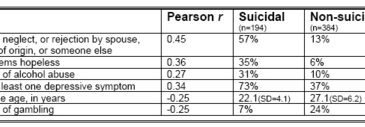Each year, 243 of the roughly 1.4 million United States military personnel take their own lives. This data ranks suicide as the third highest cause of death for the military population. Responding to this fact, the Commander of the Pacific Forces commissioned a study to investigate and identify risk factors associated with suicidal behavior. A questionnaire was developed for this special study, with items relating to 137 risk factors that investigators believed may be associated with suicidality. Between 1991 and 1994, the investigators tracked all suicidal behavior, both attempted and completed, among the 79,000 Marines on duty in the Pacific. Within 24 hours of each attempt or completion, the subject’s supervisor would fill out the questionnaire based on numerous collateral sources (e.g., peer interviews, written records). A representative control group of 384 Pacific-based Marines without histories of psychiatric disorders was assembled, all of whom self-completed the questionnaire. Selected results are listed below.
Perhaps the most interesting of the unexpected results is the negative correlation between gambling behavior and suicidality. Suicide attempters and completers were less likely to have gambled than their non-suicidal counterparts. The authors posit one possible explanation for this phenomenon: “…taking risks, such as gambling, is associated with greater tolerance for negative stressors, and hence decreases suicide potential… In other words, individuals who regularly engage in risky behaviors may paradoxically be at lower risk for suicide. These ideas are speculative and require further research.” Indeed, more research is imperative before we can draw confident conclusions about this data. Similarly, several methodological characteristics of this study must be examined. Because the questionnaire was developed exclusively for this study, the psychometric data that accompanies more established instruments is unavailable. Furthermore, the questionnaire data for the suicidal groups was derived from third parties who may not have had full information about the suicidal person, while those surveys given to the non-suicidal group were self-administered. This lack of methodological parity cannot be overlooked as a source of potential bias. Of course, the present paper represents a pilot study, and given the importance of this topic, we can look forward to a more refined analysis in coming years.
Source: Holmes, et al. (1998). Pilot study of suicide risk factors among personnel in the United States Marine Corps (Pacific Forces). Psychological Reports, 83, 3-11.
This public education project is funded, in part, by The Andrews Foundation and the National Center for Responsible Gaming.
This fax may be copied without permission. Please cite The WAGER as the source.
For more information contact the Massachusetts Council on Compulsive Gambling, 190 High Street, Suite 5, Boston, MA 02110, U.S.





